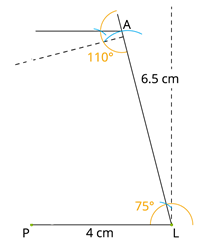
PUMPA - SMART LEARNING
எங்கள் ஆசிரியர்களுடன் 1-ஆன்-1 ஆலோசனை நேரத்தைப் பெறுங்கள். டாப்பர் ஆவதற்கு நாங்கள் பயிற்சி அளிப்போம்
Book Free Demo- Draw a side and make an angle that is given with side measure.

- Make a new angle from the newly formed side (\(X\)-axis).

- Make the given angle another. This would intersect with the axis of \(Y\) formed above. The quadrilateral is to be formed.

Example:
Construct a quadrilateral \(PLAN\) with following measurements.
\(PL = 4 cm\), \(LA = 6.5 cm\), \(∠P= 90°\), \(∠A = 110°\), \(∠N = 85°\)
The sum of the angles of a quadrilateral is \(360°\). So, \(∠P + ∠L + ∠A + ∠N = 360°\).
\(90° + ∠L + 110° + 85° = 360°\)
\(90° + ∠L + 195° = 360°\)
\(∠L + 285° = 360°\)
\(∠L = 360° - 285°\)
\(∠L = 75°\)
Step 1: Draw the side \(PL = 4 cm\) and draw the angle \(75 °\) at the point \(L\). As the vertex \(A\) is \(6.5 cm\) away from \(L\), cut the line segment \(LA\) of \(6.5 cm\) out from this ray.

Step 2: Again, draw the angle \(110 °\) at the point \(A\).

Step 3: Draw the angle \(90 °\) at the point \(P\). This ray will meet the previously drawn \(A\) ray at the \(N\) point.

Thus, the required quadrilateral \(PLAN\) has been constructed.